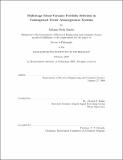| dc.contributor.advisor | Charles E. Rohrs. | en_US |
| dc.contributor.author | Rudoy, Melanie Beth | en_US |
| dc.contributor.other | Massachusetts Institute of Technology. Dept. of Electrical Engineering and Computer Science. | en_US |
| dc.date.accessioned | 2009-09-24T20:47:15Z | |
| dc.date.available | 2009-09-24T20:47:15Z | |
| dc.date.copyright | 2009 | en_US |
| dc.date.issued | 2009 | en_US |
| dc.identifier.uri | http://hdl.handle.net/1721.1/46794 | |
| dc.description | Thesis (Ph. D.)--Massachusetts Institute of Technology, Dept. of Electrical Engineering and Computer Science, 2009. | en_US |
| dc.description | This electronic version was submitted by the student author. The certified thesis is available in the Institute Archives and Special Collections. | en_US |
| dc.description | Includes bibliographical references (p. 187-190). | en_US |
| dc.description.abstract | The problem of portfolio choice is an example of sequential decision making under uncertainty. Investors must consider their attitudes towards risk and reward in face of an unknown future, in order to make complex financial choices. Often, mathematical models of investor preferences and asset return dynamics aid in this process, resulting in a wide range of portfolio choice paradigms, one of which is considered in this thesis. Specifically, it is assumed that the investor operates so as to maximize his expected terminal wealth, subject to a risk (variance) constraint, in what is known as mean-variance optimal (MVO) portfolio selection, and that the log-prices of the assets evolve according a simple linear system known as a cointegrated vector autoregressive (VAR) process. While MVO portfolio choice remains the most popular formulation for single-stage asset allocation problems in both academia and industry, computational difficulties traditionally limit its use in a dynamic, multistage setting. Cointegration models are popular among industry practitioners as they encode the belief that the log-prices of many groups of assets are not WSS, yet move together in a coordinated fashion. Such systems exhibit temporary states of disequilibrium or relative asset mis-pricings that can be exploited for profit. Here, a set of multiperiod trading strategies are developed and studied. Both static and dynamic frameworks are considered, in which rebalancing is prohibited or allowed, respectively. Throughout this work, the relationship between the resulting portfolio weight vectors and the geometry of a cointegrated VAR process is demonstrated. In the static case, the performance of the MVO solution is analyzed in terms of the use of leverage, the correlation structure of the inter-stage portfolio returns, and the investment time horizon. | en_US |
| dc.description.abstract | (cont.) In the dynamic setting, the use of inter-temporal hedging enables the investor to further exploit the negative correlation among the inter-stage returns. However, the stochastic parameters of the per-stage asset return distributions prohibit the development of a closed-form solution to the dynamic MVO problem, necessitating the use of Monte Carlo methods. To address the computational limitations of this numerical approximation, a set of four approximate dynamic schemes are considered. Each relaxation is suboptimal, yet admits a tractable solution. The relative performance of these strategies, demonstrated through simulations involving synthetic and real data, depends again on the investment time horizon, the use of leverage and the statistical properties of the inter-stage portfolio returns. | en_US |
| dc.description.statementofresponsibility | by Melanie Beth Rudoy. | en_US |
| dc.format.extent | 190 p. | en_US |
| dc.language.iso | eng | en_US |
| dc.publisher | Massachusetts Institute of Technology | en_US |
| dc.rights | M.I.T. theses are protected by
copyright. They may be viewed from this source for any purpose, but
reproduction or distribution in any format is prohibited without written
permission. See provided URL for inquiries about permission. | en_US |
| dc.rights.uri | http://dspace.mit.edu/handle/1721.1/7582 | en_US |
| dc.subject | Electrical Engineering and Computer Science. | en_US |
| dc.title | Multistage mean-variance portfolio selection in cointegrated vector autoregressive systems | en_US |
| dc.type | Thesis | en_US |
| dc.description.degree | Ph.D. | en_US |
| dc.contributor.department | Massachusetts Institute of Technology. Department of Electrical Engineering and Computer Science | |
| dc.identifier.oclc | 428978839 | en_US |
